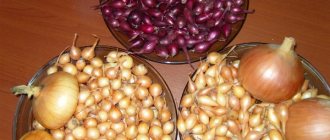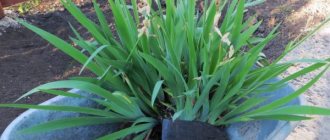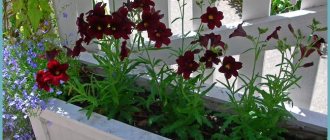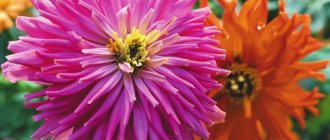Description of the plant
The canna flower belongs to the Cannaceae family and includes several dozen plant species found in the tropical regions of North America, South America, and Asia. A typical species is the Indian eland (Canna indica). In home gardens, mainly numerous, more decorative hybrids are cultivated.
Garden canna (Canna x generalis), known simply as canna, is characterized by ovate-lanceolate leaves mounted on stiff, hollow stems ending in an inflorescence. This is an extremely original perennial plant - grown for its decorative and exotic leaves and bright flowers that decorate the garden from July until the first frost.
The plant produces beautiful, very original flowers that have an asymmetrical structure and form a characteristic panicle inflorescence. Flowers are often very intensely colored:
- red,
- orange,
- pink,
- yellow.
Currently, there are unique varieties with shades of salmon or apricot, and two-tone varieties with contrasting colors are popular. The decorative effect is added by the stamens protruding from the petals.
Cannas can grow up to 2 meters, the height of the plant depends on the variety.
The canna rhizome contains a lot of starch; American tribes ate it baked.
Botanical description
Despite the monotypic nature of the family (represented by only one genus) and the small number of species, eland interbreeds well within the genus. This allows you to obtain a fairly large number of its varieties and hybrids, which have a variety of external characteristics: from height to shade and shape of flowers.
The origin of the European name canna is quite mysterious. The word "canna" means "reed" in ancient Greek. Perhaps it was obtained due to the slight external similarity of the tall stems of the plant with the stems of sugar cane. However, the similarity of these two completely different species (even belonging to different orders) ends at the stem.
canna leaves
To a much greater extent, the plant is externally similar to a gladiolus (in the structure of the stem and leaves) or an orchid (in the shape of the flower). At the same time, cannas have absolutely no smell. One of the main advantages of the plant is its almost complete invulnerability to disease.
All plants of the genus Canna are herbaceous perennials with an extensive root system. One of the important components of this system is large branched rhizomes, which contain a supply of nutrients necessary for the growth and development of the plant at the beginning of the next season. The rhizomes branch broadly in the top layer of soil , rarely penetrating to a depth of more than 20 cm.
Australian canna with purple leaves
The stems of different canna species have a wide variety of lengths. Depending on the type and variety of plant, they can reach from 60 cm to 3 m.
The leaves of the plant are powerful, large and fleshy. Their size can reach up to 80 cm in length and 30 in width.
The plant is characterized by a two-row arrangement of leaves on the stems. The color and shape of the leaves in themselves make the plant decorative even without flowers. The leaves of some canna species are not green, but have a more exotic color, such as burgundy or purple.
Canna flowers are not symmetrical: not only do they have different petal lengths, but their arrangement is also quite non-standard. The size of the flowers can be very large - from 4 to 10 cm in diameter. They are collected in paniculate or racemose inflorescences. Usually, the flowers have very bright colors. Red, yellow and orange tones predominate. White petals are very rare. The plant is dioecious, meaning the flowers are capable of self-pollination. The bract of canna flowers is quite large and oval in shape.
Canna indica flower
Depending on the species or variety, flowering occurs from mid-June to mid-July . There are also species that can set inflorescences from mid-summer to late autumn.
Canna fruits ripen towards the end of summer in cylindrical capsules . The seeds are quite large, ranging in size from 5 to 10 mm, in boxes they are arranged in two rows. As the fruit dries, the capsules crack and the seeds scatter a short distance.
Canna seeds
There are 12 types of cannas in total. It is believed that their homeland is Central America. Currently, the plant is distributed in tropical and equatorial climates in India, Australia, China and Indonesia.
In addition to its aesthetic properties, canna also has economic importance : the rhizomes, containing a large amount of starch (about a third of the mass), are used for food, and the stems and leaves are used as livestock feed.
Interesting varieties
There are numerous varieties of cannas, differing in size, color of flowers, leaves - large-flowered and less spectacular, small-flowered.
Grouping varieties by color of flowers and leaves
| Color of flowers, leaves | Varieties | Photo |
| With red flowers |
| President |
| With pink flowers |
| Pink Harmony |
| With red-crimson flowers | Crozi Livadia | Livadia |
| With yellow flowers |
| Eureka |
| With orange flowers |
| Orange Beauty |
| With white flowers |
| Ermine |
| Combined, multi-color |
| Canna Cleopatra (photo) |
| with brown-yellow leaves | Durban | Durban |
| green leaves with light stripes | Yellow Bangkok | Yellow Bangkok |
Canna flower - description
Cannas are herbaceous perennials with branched rhizomes and large leaves arranged in two rows on shortened stems. Bisexual flowers of cannas with a diameter of 4-8 cm, brightly colored in red, yellow or orange, but sometimes just white, are sharply asymmetrical: they are three-membered and equipped with a lanceolate or oval bract. Canna fruits are three-locular cylindrical or oval capsules with black round seeds that ripen in 30-40 days.
Landing site requirements
The rhizome from which the shoots grow is the main supplier of nutrients and planting material, and should produce more baby rhizomes - they will produce flowering plants next season. As the old rhizomes die off and new ones are not formed enough, it may happen that the canna will not bloom next season.
To grow beautiful cannas in open ground, it is important to provide optimal conditions for care and development - only well-watered and fertilized specimens are capable of producing thick rhizomes, from which new plants will grow next year.
The requirements for the position and place of planting canna in the garden are as follows:
- sunny, warm position;
- solitary position;
- fertile, humus, constantly moist soil with a pH of 6.5-7.0;
- A good step is to fertilize the soil with rotted manure or compost before planting in the fall or spring.
Requirements for planting in a pot:
- the pots intended for planting must be large enough to allow the rhizome to grow freely;
- it is necessary to place good drainage in the pot, which will protect the rhizome from rotting;
- The plant needs fertile, humus, permeable soil.
Advice. Cannas growing in pots may fall over, so they should be planted in large, wide-bottomed containers with additional rocks. Cannes in containers should have consistently moist soil.
Caring for canna in the garden
Top dressing
During the growing season, cannas should be fed twice or three times; mineral fertilizers are used for this. When the bushes are watered, granular fertilizer should be poured onto the surface of the soil near them, after which the soil should be loosened. For 1 square meter of land, take from 40 to 50 grams of a nutrient mixture consisting of 12 grams of nitrogen, 10 grams of potassium and 25 grams of phosphorus fertilizer.
Watering
The bushes must be watered systematically and moderately until the stems appear. After flowering begins, you need to increase the amount of watering, but you should not allow liquid to stagnate in the root system. If waterlogging occurs regularly, this will lead to the development of a bacterial or fungal disease, as a result of which the buds turn black and die.
Pests
In addition to the diseases described above, nematodes can damage the root system of cannas, and butterfly caterpillars can damage the foliage. To get rid of such pests, the bushes need to be sprayed with insecticidal preparations.
Growing
Inflorescences that have already bloomed must be removed. From the beginning to the middle of the growing season, weeds must be removed in a timely manner. When the bushes fade before the first frost, they need to be hilled up high, in this case you can protect the root collars from frost damage. When the cannas growing in the garden finish blooming, you need to start watering them less and less until the watering stops altogether.
Cannes - cultivation and care in open ground
Preparing for winter
Before frost begins, the bushes should be hilled up high, which will help protect the root collars from severe frosts; if this is not done, rot may appear on them during storage in winter. As soon as the first frosts have passed, the shoots of the bushes are cut off at a height of 15 to 20 centimeters, and then the rhizome is dug out along with a lump of earth. Then the bushes are removed to the place where they will be until the onset of spring. A cool place with diffused light and moderate humidity is ideal for this.
The rhizomes must be placed in wooden boxes, and they are sprinkled with a mixture of sand, peat, soil and sawdust from non-coniferous trees. It is best if the humidity of the mixture is about 50%, and the temperature should be from 6 to 8 degrees. During storage, systematically inspect the rhizomes, and as soon as rot appears on them, the affected area is cut out to healthy tissue, and the sections should be treated with iodine. You should also try to maintain the recommended level of humidity and temperature, avoiding sudden changes in temperature.
If desired, the rhizomes can be placed on the refrigerator shelf until spring. To do this, the rhizomes removed in the autumn must be thoroughly washed using running water, then they are placed in a solution of potassium manganese for 24 hours, after which they are dried and each tuber is wrapped individually in a paper sheet. Then they are placed in the refrigerator on the vegetable shelf, and in winter they must be systematically inspected for the appearance of rot.
Dry rhizomes can also be placed in a plastic bucket, covered with a layer of dry soil and stored on the balcony. During severe frosts, a container with tubers is brought into the house and placed near the balcony door on the floor.
Also, tubers are perfectly stored in a container in the soil in a cool room (no more than 15 degrees). The container can be placed in the attic, loggia or veranda. Water the soil once every 2 weeks with a small amount of water.
In regions with mild, warm winters, rhizomes are stored directly in the garden. They are dug up and stored in an area that is not flooded with meltwater in the spring and also has reliable protection from the wind. They should be covered with dry sawdust on top, and the layer should be about 20 cm.
Cannes - when to dig, where and how to store?
Landing
The canna plant requires a very long growing season.
In open ground
To speed up flowering and so that the flower can form thick rhizomes, improving flowering next year, it is worth planting the plants in containers already at the turn of February-March.
The rhizomes are planted in a fertile, humus-rich, permeable substrate, providing warmth in the room (15-18 degrees C).
After the leaves appear, the temperature is increased to 20 degrees Celsius during the day and 12-15 degrees at night; sufficient light must be provided.
Before planting cannas in a permanent place, they should be hardened off. It is important to respect the timing of when to plant cannas. Planting in the ground is carried out after May 15, when there is no danger of frost.
Distances must be maintained:
- 30 × 50 cm – for low grades;
- 60 × 90 cm – for tall ones.
The rhizomes are placed horizontally in the holes, and a layer of earth 5 cm thick is poured over it.
In the pot
From rhizomes that look like in the photo below in March, you can grow a beautifully blooming canna at home.
How to plant cannas in a pot - step by step:
- The rhizome has already developed sprouts and roots, so there will be no problems with rooting.
- To achieve the ideal goal, choose a pot of a size so that the rhizomes fit into it. Fill the pot halfway with peat soil.
- Place the rhizome in the pot and cover it with soil.
- After about 3 weeks, you can start to see how quickly the kana grows.
- This is what the root system looks like 5 weeks after planting.
Attention! Immediately after planting the canna, water should be poured very sparingly so as not to flood the plant. It should be remembered that at the initial stage the rhizome does not have fully developed roots, so it cannot absorb excessive amounts of water and may rot. It is enough to keep the substrate slightly moist.
At this stage of rooting, the plant does not need light. Temperature is important. The higher the temperature, the faster the development. The optimal temperature for rooting canna in a pot is 18-22 ° C.
Growing canna in the garden
Sowing seeds
When sowing canna seeds, it should be taken into account that the emerging seedlings are often not able to retain the varietal characteristics of the parent plant. You also need to remember that not all varieties are capable of setting seeds. In this regard, the most popular among gardeners is the vegetative method of propagation - dividing the rhizome.
However, if you have a strong desire, then it is quite possible to grow such a flower from seeds. Its seeds are covered with an extremely durable and dense shell, which must be softened before sowing. To begin with, the seed must be doused with freshly boiled water, and then it is placed in a thermos, into which lukewarm water is poured, where it should remain for 3 to 4 hours. Instead, it can be placed on a hot radiator for 12 hours. Also, instead of seeds, you can freeze them, to do this they are placed in the refrigerator for 1–2 hours.
Sowing of seeds should be carried out in February, using a light substrate, the air temperature should be from 22 to 23 degrees, the crops require partial shade. The first seedlings should appear after 20–30 days; they should be picked into individual pots after the formation of 3 or 4 true leaf blades. Before transplanting into open soil, seedlings should be kept in a cool place (about 16 degrees). Some of the seedlings are capable of blooming already in the current season, while for the other part, flowers will form only next year.
Growing tubers
A more reliable method of propagation, which will allow you to obtain bushes that bloom in the summer, is the method of dividing the tubers. In the first days of March, divide the tuber into parts, with each section containing several weak buds or one large one. The cut areas must be treated with charcoal powder and dried. Place the cuttings in a greenhouse container very tightly to each other; they should be placed on the surface of sand or soil, and the buds should be placed horizontally. The top of the cuttings should be covered with a layer of sand, which should be periodically moistened with lukewarm water from a spray bottle. It is best for the buds to germinate at an air temperature of 20 to 24 degrees; for this, experts advise slightly heating the container from below. After the foliage appears on the divisions and they become crowded, they will need to be planted in individual small pots, which are placed in a well-lit and cool place (about 16 degrees). They will stay there until transplanted into open soil, during which time they will have time to get stronger; once every 10 days the bushes must be watered with a solution of potassium permanganate (2 grams per 1 bucket of water). Some gardeners prefer not to grow canna tubers, as a result of which flowering begins much later, and in some cases the bushes do not bloom at all.
When to plant cannas
After the spring return frosts are behind us, you can begin to prepare the area for planting. This flower prefers well-lit areas that have reliable protection from drafts. The soil should be rich in organic matter, nutritious and warm. Canna needs exactly the same growing conditions and care as a cucumber. A soil mixture consisting of leaf soil, peat, humus and coarse sand (1:1:1:1) is ideal for growing it. At the bottom of the holes you need to make a good drainage layer.
Experts recommend planting such a flower in open soil no earlier than May 9. The fact is that if in the spring the bushes are exposed to sudden changes in temperature, then their growth will slow down and they will bloom much later or will not bloom at all.
Canna from seeds
Landing
Cannas should be planted from mid to late May, but only after the frosts are definitely behind us. In order for the bushes to grow and develop very well, they will need to make a “hot” litter. To begin, make a planting hole, reaching 0.5–0.6 m in diameter, and at its bottom make a good drainage layer of fresh manure, the thickness of which should be about 20 cm. Thanks to the manure, the root system of the flowers will always be warm, which will cause active growth and lush flowering of bushes. The manure must be covered with soil, and the layer thickness should be about 25 cm. After the soil has been watered abundantly, bushes are planted in it, which are then dug in. When planting an unsprouted onion, it should be planted to a depth of no more than 60–90 mm. The distance between the bushes and the row spacing should be about 50 cm. After planting in the soil, only 6–8 weeks will pass and the bushes will bloom.
Features of cultivation
The plant is unpretentious in cultivation, loves fertile soils and watering, and requires special wintering conditions. To prolong the flowering of canna, faded inflorescences should be removed.
Watering
Growing canna in the garden involves systematic watering. Producing large amounts of greenery requires a constantly moist substrate, so it is important to water mature plants regularly. In too dry soil, plants will not reach a satisfactory size and may not bloom. Water frequently:
- 2-3 times a week in open ground;
- 4-5 times a week when grown in a pot.
Fertilizer feeding
Caring for cannas includes systematic fertilization - every 2 weeks you need to apply fertilizer for flowering plants.
Wintering tubers
Cannes in our climate are not frost-resistant. To enjoy the flower for more than one season, you need to dig up the rhizomes and store them in winter in a place not exposed to frost.
Preparation for wintering and storage of tubers includes the following procedures:
- The tubers are dug up, the above-ground part is cut off at a height of 10-15 cm;
- the rhizomes are slightly torn off the ground, dried and stored in the basement - on shelves or in containers, covered with damp peat;
- during the dormant period, the room where the rhizomes are stored must be maintained at 5-8 degrees C;
- In winter, it is worth inspecting the tubers several times - in case of any damage, infected rhizomes are immediately removed and thrown away.
Cannas tolerate a temporary drop in ambient temperature below 0 degrees C. It is important not to miss the deadline when digging up the canna - the procedure is carried out after the first autumn frosts in two ways:
- When the first frost catches the leaves, cut them off with a sharp knife at a height of 10-15 cm from the ground. Using a large shovel or pitchfork, carefully dig out the root ball.
- First, we dig up the entire plant, then cut off the stem with a sharp knife.
If we have a small number of plants, the second method is more convenient and faster - the truncated rhizomes do not become contaminated. The first method is useful where there is not enough space for a large number of cut leaves.
If it is not possible to maintain the required temperatures, in order to keep the plant tubers in good condition throughout the winter, you need to frequently ventilate the room. To prevent the roots from becoming too dry, it is worth covering them with damp peat or a layer of sawdust.
Cannes Features
Externally, the canna bush is similar to a hybrid of an orchid or gladiolus and a banana. This plant has a couple of disadvantages, namely: when grown in mid-latitudes, its flowers do not have a scent, and it can also freeze out in too cold a winter. Otherwise, gardeners are completely satisfied with this plant.
Canna is highly resistant to disease, so even an inexperienced gardener can cultivate it. This plant is very impressive and is distinguished by its unpretentiousness and resistance to drought. It blooms for a very long time from the last days of June until the first frost. The branching rhizome of the canna grows in breadth. The erect flowering stems are tall (60–300 cm) and thick. Powerful large leaf plates are pointed, their shape is elliptical or oblong, their length can vary from 0.25 to 0.8 m, and their width from 0.1 to 0.3 m. Thanks to the color and shape of the foliage, the plant looks very impressive. But it looks most decorative after its incredibly beautiful flowers open. Bisexual, sharply asymmetrical flowers range from 40 to 80 mm in size and are red in color. As a result of breeding work, varieties with flowers of pink, yellow and orange were born; there are also bordered, bicolor and speckled varieties. The rarest are the cannas with white flowers. The flowers are part of racemose or paniculate inflorescences. The fruit is a three-lobed capsule.
Cannes. Landing. Excavation. Storage.
Reproduction
Cannes are propagated in several ways:
- vegetative - dividing the bush;
- generative - seeds
Reproduction by dividing the underground part
Canna reproduces most easily by dividing the rhizome into smaller fragments with at least 1-2 buds. The plant is propagated in this way in the spring, before planting. The tubers are dug out from the substrate, washed from the soil, the wounds are dried, and sprinkled with charcoal.
Propagation by seeds
When deciding on generative propagation (seed sowing), it should be remembered that the resulting seedlings will not exactly replicate the characteristics of the mother plant.
The seeds should be soaked in warm water for about 24 hours before sowing, then sown in permeable soil, ensuring a temperature of about 21°C.
Photo. Germinating canna seeds
Seeds that have been previously germinated are planted separately in small containers. If you have several seeds, you can plant them directly in pots with a cross section of 7x7 cm, and when the roots outgrow the pot, we transplant them again into pots twice as large - 14x14 cm.
Seedlings need to be cared for throughout the summer to ensure beautiful flowers next year, the size and color of which cannot be completely predicted. If the seeds are sown in early January, there is a high probability of getting flowering plants this year.
This is interesting! The seeds are so heavy that they were previously used as weapons or as beads to make jewelry.
Brief description of cultivation
- Landing . Seeds are sown for seedlings in February, tubers are planted in mid-May, and sprouted tubers are planted from the first days of March.
- Bloom . It starts in July and continues until frost.
- Illumination. Needs a lot of light.
- Soil . The soil should be nutritious, rich in organic matter, well drained and warm.
- Watering . It is necessary to water moderately, but systematically. However, during the flowering period it should be abundant.
- Fertilizer . You need to feed twice or three times during the season; for this, mineral fertilizers are used.
- Reproduction . Seed method and rhizome division.
- Harmful insects . Nematodes, butterfly caterpillars, scale insects, spider mites, aphids, slugs.
- Diseases . Rust, gray rot, variegation, cucumber mosaic virus.
Diseases and pests
Cannas usually do not suffer from serious diseases. Although they can be affected by some diseases:
- viral diseases are signs of damage: plants do not bloom, do not have bright spots on the leaves, various types of deformations are observed;
- fungal (for example, rust);
- bacterial (canna bacteriosis).
The development of viral diseases is facilitated by unfavorable stressful growing and care conditions:
- strong sunlight,
- quick location change,
- high humidity,
- soil is too wet.
The plant can be affected by pests:
- aphids,
- snails and slugs,
- wireworms,
- nematodes.
Slugs are easy to catch in the evening, using beer traps; you can read more in the article on how to get rid of slugs. The presence of pests can be indicated by traces of dried mucus and round eggs in cracks in the ground and secluded places.
Aphids are destroyed with chemicals; a drug called Confidor 200 SL in a 0.04% concentration is suitable, that is: 4 ml per 10 liters of water.
Cannes varieties
Asian. The common ancestor of all modern Canna species is the South Asian Canna. It was given the name garden canna, due to the domestic types bred as a result of the long-term work of breeders. As a result of the selection, three hybrids were bred.
Canna Crosi is a plant that looks like a gladioli. The species is distinguished by its short stature, its average length is 100 cm. The flower petals have a beautiful purple or dark shade of green with a white coating.
The initial Crozy hybrid was obtained back in 1868 and after that, many varieties were formed. The best of them: Livadia, America and President.
Why doesn't canna bloom?
The reasons are different, usually it is a violation of planting dates and care features.
- If the plant planted in May was too small and had little time to grow well, then there will be no flowers this year.
- This flower from South America and Mexico needs a long growing season and plenty of warmth. If the summer is cold, flowering may not occur.
- If the rhizomes were planted in a too shady place, this will limit the development of the plants.
Features of canna growth
With proper planting and quality care, the crop can delight you with its flowering from June until late autumn. Before you start growing a flower, you need to familiarize yourself with its growth:
- With active growth, rhizomes begin to develop in width. When planting, a large distance must be left for root development.
- The development of the culture begins with the powerful upward growth of the main stem. In terms of external characteristics, the plant stem is more like bamboo. The gardener focuses on the development of the arrow when planting a crop in the soil.
Use in landscape design
Usually flowers are planted in numerous groups to show off the maximum beauty of the flower. Cannes look good in various compositions:
- near the pond;
- against the backdrop of a lawn;
- as an element of the discount;
- in a composition in a flowerbed;
- used for planting in pots, containers on terraces, balconies - varieties are planted whose height does not exceed 60 cm;
- the plant is often an element of urban greenery.
Canna is one of the most popular flowering plants in the garden. Its intensely colored flowers are a very interesting element of every flower bed. The unusual shape and bright color make the plants a little exotic. Knowing how to care for cannas, it is easy to achieve beautiful blooming of huge flowers in your garden.
Features of the plant
At first glance, the canna flower looks like a hybrid of a banana with a gladiolus or orchid. The plant has only two disadvantages: in our latitudes it does not overwinter well in the open ground and does not smell at all. All other characteristics are pure advantages. The main thing is that the plant is almost never sick, so growing canna will not cause any trouble even for a novice gardener. Canna, for all its beauty and decorativeness, is generally unpretentious, drought-resistant, and decorates the garden with flowering from the end of June until frost.
- Photo of asparagus Sprenger
The canna rhizome branches, growing in breadth. Flowering stems are erect, thick, tall (from 0.6 to 3 m). The leaves are large, powerful, pointed, oblong or elliptical in shape, reaching a length of 25-80 cm and a width of 10-30 cm. The shape and color of the leaves makes the plant attractive even without flowers, but only when the canna blooms will you understand that such beauty and harmony. The flowers are sharply asymmetrical, bisexual, 4-8 cm in size, the original color is red, but today, thanks to the work of breeders, varieties of yellow, pink, orange flowers have been developed, there are bicolors, with a border and even speckled. White elands are the least common species. The flowers are collected in paniculate or racemose inflorescences. The fruit is a three-lobed capsule.
Storing canna in winter
At the end of August, the cannas are transplanted into containers, which can be easily brought indoors if there is a threat of frost. The final digging is carried out in the last days of September or the first days of October; the flowers are not frost-resistant. To improve the wintering of cannes, it is important to create an air temperature of +7…+15 ºC. She has no noticeable rest period.
The plant pleases the gardener with its beauty all year round. However, in order for the flowers to enter the blooming stage, it needs to create conditions. For 2 months, cannas are stored in a cool place with little lighting, while reducing watering. After digging, storage is carried out in perlite, sphagnum moss or peat, poured into plastic boxes, at a temperature of +6...+8 ºC. They try to avoid touching the tubers. Twice a month the condition of the rhizomes is checked, if necessary, wetting the materials with which they are covered with water. The damage is removed and the cut area is treated with iodine.
Storage
As soon as the first frosts appear, the canna should be sent for storage. Last year I dug it up at the beginning of October.
First, I cut the stems at about a height of 20 cm. The rhizomes had grown greatly over the summer, so it was quite difficult to dig it up so as not to damage the roots. Next, I lightly shook off the soil. I put newspaper in the tray and rhizomes on top. Some people sprinkle it with sawdust, peat or sand, but I didn’t do that.
When they dried out a little, I sent them for storage in the basement, where the air temperature is approximately 6-8°C. My basement is quite humid, but if the rhizomes do not have enough moisture and they begin to dry out, it is better to sprinkle them with water. There they slept with me throughout the cold winter.
Care
Watering
It is necessary to water every week and be sure to loosen the soil after watering. If there is no rain, you can water more often.
Top dressing
Throughout the growing season, canna requires feeding. Many people recommend feeding with complete mineral fertilizer at least three times during the entire growing season. I did it a little differently. Since I read that this tropical plant is similar to the development of the cucumber, a plant of tropical origin that is still very familiar to us, I fed it in exactly the same way: every week with green fertilizer from nettles and clover.
Diseases
Although my cannas were not sick with anything last summer, I know that they can be attacked by aphids or spider mites. They can also be affected by nematodes or rust. The most dangerous disease for them is a viral or mycoplasma infection. With it, a ring or streaked spot appears.
There is no need to be afraid of anything, but simply fight it the same way as with diseases on other flowers. The first rule for me is this: in order to avoid numerous diseases (this applies to all plants and flowers), you must try to follow all the rules of agricultural technology. This is an absolute axiom.
Deciduous Cannes
The tallest Canna plants reach a height of 3 meters. They have very picturesque leaves of various shades, but the flowers are small, only 6 cm.
The most popular Durban variety is a flower with yellow and orange hues and beautiful leaves that will be a real gem in any garden. Choose a plant to your liking, and numerous photos of Canna on the Internet will help you make the right choice.
Mr. Summer Resident recommends: canna in the landscape
Cannas are good both in group plantings and planted individually, which is why they are loved by landscape designers. It is good to plant against the background of low-growing plants: marigolds, coleus, cineraria. Combine with kochia, perilla and petunia.
Orchids
When planting with other flowers, provide a central position by placing medium-sized and low flowers around. When planted in groups, they are placed in the form of wide and long ridges.
Summer balconies, loggias and terraces are decorated with flowers, planted in a flowerpot or large tub.
Preparing space and planting material for planting in the garden or dacha
Planting material is first germinated at home and only then replanted. And since planting material is quite expensive and is not always found in the store, it is worth saving the dug up rhizomes for subsequent years. Some amateur gardeners grow cannas from seeds. But this is a labor-intensive process.
Summer residents have one trick for long and lush flowering of the plant - make organic litter. It is usually made from horse manure, which is placed on the bottom and then covered with soil. Thanks to the combustion process, heat will appear, which contributes to prolonged flowering.
Canna flowers - planting
By the time of planting, a sprout and well-developed growth of young roots should be visible.
First, the rhizome is placed in a hole and all the roots are covered with earth. Then the soil is lightly compacted and the plant is watered with warm water. Water takes about 5-7 liters per plant.
Plants are planted at a distance of 0.5 m from each other, the same distance between adjacent rows. If the canna takes root in place, it usually blooms within 2 months.
It is necessary to fertilize 3 times per season. Every 10 days, during watering, place a little manganese under the flowers. Mineral and organic fertilizers are scattered around the plants after watering, and then loosen the soil. 2 weeks before flowering, many feed cannas with chicken droppings, which are diluted in water. Water every day, but little by little. Water the flower abundantly only before flowering. It is better to take warm water for this.
Canna flowers - growing in the garden
Important! When the cold weather begins, the leaves turn black, at which time the plant should be dug up. Cut the flower stems almost to the root. Next, dry the roots well and put them in a box for the winter. It should be stored in a room where it is cool and free of moisture.
The easiest way to plant canna is using divided rhizomes. Seed cultivation is also practiced, but it is associated with a number of difficulties. This is primarily due to the fact that most plant varieties do not pass on their varietal characteristics to their offspring. Some varieties do not set seeds at all, propagating exclusively by vegetative means.
Common canna varieties
- Indian. A slow growing plant reaching a height of 2 meters. The leaves are smooth, light green or with red veins, 50-70 cm long. The variety does not bloom abundantly; it is bred as a deciduous species. Flowers of pink, fawn and red colors are 10 cm in diameter.
It is used for landscaping fences, gazebos and local areas.
- Hanging. An evergreen species reaching a height of 1.2 meters. The leaves are narrow, 50-60 cm long and 13-15 cm wide, rich green in color. The flowers are grayish-yellow or red, 6-8 cm in diameter.
Planted along the banks of reservoirs to decorate pools and ponds.
- Low. Plant height up to 1.5 meters. The leaves are elongated, bright green, 50 cm long. It blooms profusely and in dense inflorescences in a combination of red, orange and yellow shades.
Planted in flower beds in combination with other flowers and as a tapeworm on lawns and lawns.
The most popular varieties for growing in gardens: America, German Titov, Clara Buisson, Sunny Beauty, President and Livadia. They are distinguished by abundant flowering with large buds and unpretentiousness to cold weather. They bloom from early June to October.
Recently, several varieties have been developed that, in addition to gorgeous flowers, have a very unusual leaf shape, which only increases the attractiveness of the plant.
Home Canna
The home flower Canna also successfully exists as a potted plant. Small types of plants that fit in your apartment become the heart of the decorative garden of many flower lovers.
Ten months out of twelve Canna will delight with its beautiful flowers and petals. And she only needs peace for two months. It is recommended to store the flower in a larger pot so that the roots can grow unhindered.
Tulips for March 8: varieties, planting dates and forcing methods
- Brugmansia: planting, growing, care and propagation in open ground. 75 photos of a beautiful flower
Petunia - growing from seeds. Instructions for care, propagation and planting at home (110 photos)
Reasons for popularity or why cannes are so in demand
cannas can be planted individually or added to a flower arrangement
When choosing which flowers will be the best and undemanding decoration for a flower garden, be sure to take a closer look at the cannas. It’s not for nothing that they are the favorites of designers when decorating city flower beds; they are planted as a separate plant or as part of compositions. There are several reasons for these magnificent flowers to appear on your site:
- Plants are undemanding and do not require special care. They practically don't get sick. They are not afraid of pests. They can easily tolerate short-term drops in temperature. They are drought-resistant plants.
- The flower amazes with the beauty of the inflorescence. Its beautiful large shape will definitely become the center of attention of the flower bed and flower garden.
- Canna has a long flowering period: about two months it will delight with large flowers beautifully collected in inflorescences.
- A flower decorates a flowerbed not only due to its inflorescences. Currently, there are plants with beautiful decorative leaf shapes that look great in the garden.
- The plant itself is distinguished by a thick, fleshy stem up to 2 m high. The straight shape fits beautifully into the floral ensemble. And the strong stem can withstand wind loads.
Kanna: appearance
unusual two-color canna flower
As noted, canna is a large plant with a thick, straight stem that does not need to be supported. An adult healthy flower is capable of throwing three to four arrows. The height can be from half a meter to two. These sizes allow the flower to be grown both in the ground and in flower pots. There is no significant difference in care. Here are some features of canna:
- Cannas are perennial plants. Their heat-loving nature is incompatible with the cold Russian winter. Therefore, when overwintering in open spaces, the plant most often dies.
- A feature, and some consider this property a disadvantage, is the lack of odor.
- The flower blooms four months after the start of shoot development. Flowering begins in July and lasts about two months, or even until the first frost.
- Canna is a large flower from 3 to 15 cm in size, reaching 30 cm in inflorescences, painted in any shades of yellow, red, burgundy and orange. 10 mm is considered standard. Most often colored red, yellow shades are less common. The snow-white color is unique. It can be either plain or dotted or striped.
- The canna stem has large, oblong, elongated leaves that are significant in size. Can be up to 80 cm.
delicate Salmon Pink canna flower
Cannas are heat-loving plants, so they do not like early planting in open ground. But it is also worth considering the fact that the sooner a flower begins to develop, the faster it will bloom and begin to decorate the flowerbed. Therefore, for planting, a technique is used in which the flower is germinated in advance and thereby artificially helps to begin flowering earlier.
Some canna varieties grow well in containers of water. In this case, in the summer they are planted in an open pond on the site, and in the winter they are transferred to the winter garden. With this planting order, it is additionally necessary to provide artificial lighting for the flower; the winter sun will not be enough for it. The temperature required for plant growth is 15 degrees.
Canna: most common varieties
there are more than 50 varieties of cannas
Cannes are very popular flowers that are loved by collectors. Currently, the trading network offers a large number of beautiful varieties, differing in the size and color of the flower, stem height, and decorative features of the leaves. Even the most demanding lover can find a variety that will satisfy his most sophisticated needs.
The following varieties are most widespread:
- Indian eland is one of the most common and unpretentious. Easily grown in garden beds. It does not require special care. It belongs to the dwarf varieties, its average height is just over half a meter. Perfect for forming borders. Planted in containers located around the site, it will decorate any suburban space with its excellent appearance. The leaves initially have shades of soft green, which gradually darken during the summer. The plant compensates for its low growth with its stunning colors and appearance of inflorescences.
Indian eland
- The Durban variety hides a tall canna that can reach up to 3 m in height. They are most valued for the coloring of their leaves; they look especially impressive in the autumn flower garden when decorating fences and buildings.
Durban variety with bright orange flowers
- Canna Pak, which does not tolerate temperature changes well, has a creamy white inflorescence. Very beautiful and delicate, reminiscent of an elegant gladiolus.
Pak variety
- The America variety is popular, height up to 1.5 m. The red flower is stunning with its size of 10 cm.
canna america
- The Salmon Pink variety is distinguished by its short height of half a meter, unusual salmon-colored flower color and striped coloring of decorative leaves. This helps the plant take center stage in the flower bed.
Salmon Pink variety
Cannes: growth features
With proper planting and well-organized care, the plant is able to delight the owner with its flowering from June to late autumn. Before you start growing, you should familiarize yourself with its features:
- The rhizome develops in width as it grows. When planting, you need to leave space for root development.
- The development of the plant begins with the powerful upward growth of the central stem. In appearance, the stem resembles bamboo. The development of the arrows is guided by when planting a plant in the ground.











